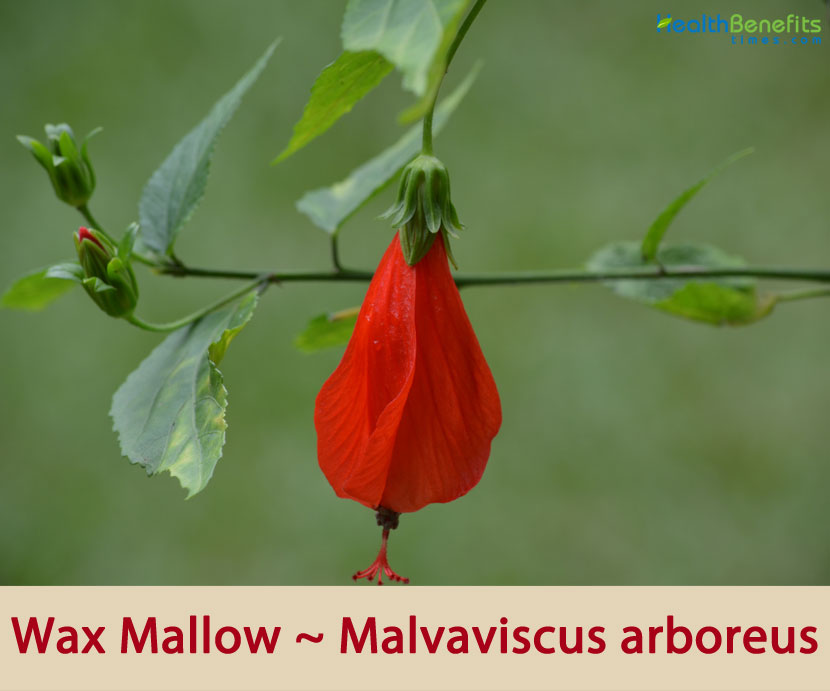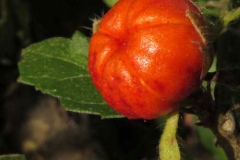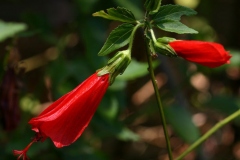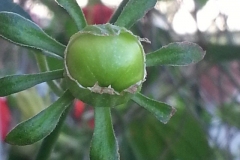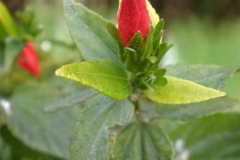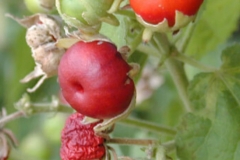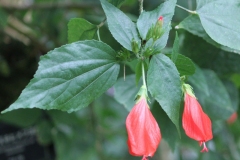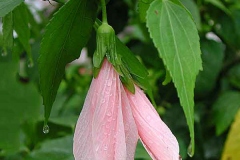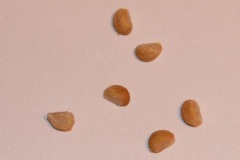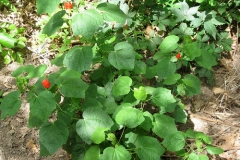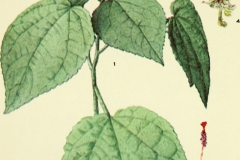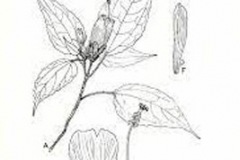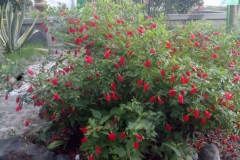| Wax Mallow Quick Facts | |
|---|---|
| Name: | Wax Mallow |
| Scientific Name: | Malvaviscus arboreus |
| Origin | Southeastern United States, Texas, Mexico, Central America and South America |
| Colors | Initially green turning to bright red when ripe |
| Shapes | Red, fleshy, berry-like capsule, globose-cylindrical, about 1.5 cm across |
| Taste | Taste like apples but with very little tartness, mainly just a light sweetness |
| Health benefits | Beneficial for bronchitis, cystitis, diarrhea, dysentery, fever, gastritis, hypertension, kidney diseases, liver and gallbladder problems, stomachache, sore throat, tonsillitis, and wounds |
| Name | Wax Mallow |
|---|---|
| Scientific Name | Malvaviscus arboreus |
| Native | Southeastern United States, Texas, Mexico, Central America and South America. It can be found cultivated and naturalized in China, Thailand, Vietnam, Singapore, West Indies, the Galapagos Islands, New Zealand, and on several islands in the Pacific Ocean (i.e., Fiji, New Caledonia, Hawaii and Tonga). It has become naturalized in most of Florida and is not considered to be invasive |
| Common Names | Bootblack Flowers, Cardinal’s Hat, Drummond’s Wax-Mallow, Firecracker, Firecracker Hibiscus, Hibiscus-Piment, Ladies Teardrop, Mexican Turks Cap, Old Man’s Apple, Pepper Hibiscus, Scotchman’s Purse, Sleepy Hibiscus, Sleepy Mallow, Texas-Mallow, Turk’s Cap, Turk’s Turban, Turkcap, Wax Mallow, White Moho, Wild Apple, Drummond’s Turk’s Cap, Red Mallow, Mexican Apple, Sleeping Hibiscus, Bleeding Hearts, Manzanita |
| Name in Other Languages | Afrikaans: Rooi pylblom Assamese: Pahimuja-joba, Tikoni-joba Bahamas: Sagra’s malvaviscus Belize : Catusa, Tulipán, Tulipan Del Monte, Tulipancia, Tulipancillo, Tulipanoia, Old Man’s Apple, White Moho, Wild Apple Bengali: Lanka Jaba (লংকা জবা) Bolivia : Malvavisco Arborescente Brazil : Malvaisco Chinese : Xio Xuan Ling Hua, Xuán líng huā (悬铃花) Cook Islands : Kaute, Kaute Moe, Kaute Makatea, Kaute ‘Ōporo Costa Rica : Amapola, Amapolilla Cuba : Majaguilla Danish : Kræmmerhusmalva, Søvnig Hawaiiblomst Dominican Republic: Bombillito, platanito Dutch: Wasmalve English: Turk’s-cap, Wax mallow, Sleeping hibiscus, Turks cap, Fire dart bush, Chinese hat, Drummond’s wax-mallow, Texas-mallow, fire-dart, Firecracker Hibiscue, Ladies teardrop, Turk’s turban, marsh-mallow, scarlet rose-mallow, wild cotton Estonian : Pehme Malvavisk El Salvador : Manzanita Quesillo Finnish: Tarhamalva French : Calalou Diable Hibiscus Dormant, Malvaviscus Arboré Du Mexique French Guyana : Calalou-Diable German : Beerenmalve, Gewöhnliche Beerenmalve, Mexikanische Beerenmalve, Wachsmalve, Strauchförmige, strauchförmige Beerenmalve, strauchförmige Wachsmalve, Guatemala : Clavel Encarnado, Estrella De Panama Hawaiian : Aloalo Pahupahu Hindi: Juba kusum, lanka jaba, mattu chemparati Japanese: Kôshotsuki, momiji-aoi, Koushiyotsuki (コウシヨツキ), Momijiao (モミジアオ) Jamaica: Mahoe rose, sugar bark Kannada: Sanna dasavala Lesser Antilles: Hibiscus-piment, sleepy mallow Malayalam: Mottu Chemparathi, meāṭṭucemparatti (മൊട്ടുചെമ്പരത്തി) Malaysia : Bunga Raya Kuncup Manipuri: Juba Kusum, Juba kusum (জুবা কুসুম) Maori (Cook Islands): Kaute, kaute ‘oporo, kaute makatea, kaute moe Mayan : Amapola, Amapollila, Arito, Bizil, Capuchito, Capuyito, Chillilo, Civil, Flor De Arito, Mahoe Rose, Malvito, Manzana, Mapola, Managuillo, Obelisco De La Sierra, Papito De Monte, Pico De Gorion, Polvo De Monte, Poro,Quesito, Resucitado De Monte, Sobon, Tamanchich Mexico : Civil, Manzanilla, Manzanita, Mazapan, Monacillo, Moanacillo Coloradol Nicaragua : Quesillo, flor de los santos Persian: پنیرک درختی Peru : Cucarda Caspi, Malvavisco,Pinon Ceqeati, pinon Portuguese: Malvavisco Puerto Rico: Capucha de monje Pukapukan : Kaute Russian: Malʹvavyskus drevovydnyy (мальвавискус древовидный), mal’vovnik drevovidnyy (мальвовник древовидный) Saint Lucia: Mazapan Spanish : Flor De Santos, Manzanillo, Monacillo, Obelisco De La Sierra, Tripa De Buey, Tulipancillo, amapola, arito, bombillo, capucha de monje, majagu illa, malvavisco, quesillo, malvavisco arbóreo, Manzanita, papito de monte, quesillo Swedish: Bärmalva Thai : Chaba Tuamotuan : Aute’Umoa United States Virgin Islands: Sleeping hibiscus Vietnamese : Bụp Giàn Xay, Bụp Kín |
| Plant Growth Habit | Erect, spreading perennial, deciduous herb or shrub |
| Growing Climates | Waste places, wet areas, coastal areas, disturbed sites, mesic forests, riversides, secondary forests, sandy pine woods, in scrub oak woods, along fence rows, and on dunes |
| Soil | Thrives best in a diverse range of well- drained, moist soils, in full sun or partial shade |
| Plant Size | Around 10 to 14 feet long around 3 feet wide |
| Stem | Stems of the wax mallow are woody toward the plant’s base, but fuzzier and greener toward the branch tips. |
| Leaf | Alternate, petiolate, unlobed or shallow 3-5 lobed after the middle part towards the apex, broadly ovate-elliptic to lanceolate, about 4-22 cm long and 3-13 cm across, base rounded 5-9 veined, margins coarsely crenate-serrate or rarely entire, apex acute to acuminate, sparsely pubescent with simple and stellate hairs both above and beneath |
| Flowering season | June, July, August, September, October, November, December, January, February |
| Flower | Red, usually solitary in upper leaf axils, pendulous, corolla funnel-shaped, 5-6 cm long, five petals slightly left-rotated to roll, not spreading, style slightly longer than corolla. Corolla is 3-5 times longer than calyx, involucract bracteoles spatulate |
| Fruit Shape & Size | Red, fleshy, berry-like capsule, globose-cylindrical, about 1.5 cm across, 3–4 seeded. |
| Fruit Color | Green when young turning to bright red when ripe |
| Seed | Seeds are reniform or subglobose and are brownish colored. |
| Varieties |
|
| Propagation | By seeds and vegetatively by layering and stem cuttings |
| Taste | Taste like apples but with very little tartness, mainly just a light sweetness |
| Plant Parts Used | Flowers, fruit, young leaves |
Plant Description
Wax Mallow is an erect, spreading, multi stemmed, perennial, deciduous herb or shrub that normally grows around 10 to 14 feet tall and around 3 feet wide. It is a colonial plant with stems rooting when they meet the soil. Stems are erect or arching, green in color, and pubescent. Older stems are glabrous with thin, smooth, papery bark. Stems are thickly covered with stellate hairs. It can also be considered a dwarf variety of Sleeping Hibiscus. The plant is found growing in waste places, wet areas, coastal areas, disturbed sites, mesic forests, riversides, secondary forests, sandy pine woods, in scrub oak woods, along fence rows, and on dunes. The plant thrives best in a diverse range of well- drained, moist soils, in full sun or partial shade. It is drought tolerant and deer resistant.
Leaves
Leaves are alternate, petiolate, unlobed or shallow 3-5 lobed after the middle part towards the apex, broadly ovate-elliptic to lanceolate, about 4-22 cm long and 3-13 cm across, base rounded 5-9 veined, margins coarsely crenate-serrate or rarely entire, apex acute to acuminate, sparsely pubescent with simple and stellate hairs both above and beneath. Petiole is puberulent, about 2-5 cm long. Stipules are linear spathulate, caducous, about 3-5 mm long.
Flower
Flowers are red, usually solitary in upper leaf axils, pendulous, corolla funnel-shaped, 5-6 cm long, five petals slightly left-rotated to roll, not spreading, style slightly longer than corolla. Corolla is 3-5 times longer than calyx, involucract bracteoles spatulate. Petals are with prominent auriculares at base, stamens aggregated into columns, longer than petals, petals only slightly spread distally, barely fruitless. Wax mallow has a bright red flower with orange red and odd red veins. It blooms throughout the year in the tropics, from September to late December. Wax mallow can be described as a non-flowering hibiscus, but in fact, rather than saying that it does not flower, its petals do not open. To judge whether it is flowering, just look at whether the stamens out of the corolla, the stamens out of the corolla, until the stamens wilting before it is in bloom. Wax mallow blooms year-round. The orange flowers have delicious nectar and are sweet. The most distinctive is that its petals are not opened, only stamens and pistils out of the petals, the whole flower is like a girl with shame wrapped tightly in a red robe.
Fruit
Fertile flowers are followed by a red, fleshy, berry-like capsule, globose-cylindrical, about 1.5 cm across. The fruit are edible. Seeds are reniform or subglobose and are brownish colored.
Health benefits of Wax Mallow
Listed below are few of the popular health benefits of Wax Mallow
1. Fever, Cough, Cold, & Flu
The antipyretic properties of this herb make it great to lower fevers. Its demulcent action helps to calm a sore throat and decrease coughing. It also helps to boost the immune system in general, largely due to the high vitamin C content. These properties make Wax Mallow a great plant to use in the case of cold or flu.
2. Hypertension
Not only is this herb a cardio tonic, helping to improve the health of the cardiovascular system as a whole. It also is a diuretic that helps to lower blood pressure.
3. Diabetes
Many traditional cultures use Wax Mallow flowers for controlling blood sugar. This is normally useful for both type 1 and type 2 diabetes.
4. Gallbladder
Flowers of this plant are high in vitamin C and other nutrients that help reduce the occurrence of gallstones. Some traditional cultures also use these flowers to help treat existing gallstones.
5. Skin & Hair
The demulcent properties of the leaves and flowers can help to soothe irritated, itchy skin. This extends to the scalp where the herb also helps to slow balding and may even help to promote the growth of hair in some cases.
Traditional uses and benefits of Wax Mallow
- The plant has been used in traditional medicine in Central America and Haiti.
- Cubans use a flower decoction as gargle for sore throat.
- Dominicans apply the leaf juice to lice, seborrhea and wounds, and a flower decoction is given to nursing infants with cold.
- Haitians and Mexicans drink the flower decoction for bronchitis, diarrhea, thrush and tonsillitis.
- Hondurans drink the leaf decoction for fever.
- Leaf decoction is used by Costa Ricans for the treatment of cystitis, diarrhea, gastritis, and sore throat.
- Flower decoctions are used to treat bronchitis and fever.
- Flowers reduce low-grade systemic inflammation when the lymphatic system is congested.
- The leaves of the plant have been used as an emollient to treat inflammation, soothe itching, and soften skin.
- Mexicans used the flowers of the plant to treat digestive inflammation and as a menstrual aid.
- The plant is known to cure bronchitis, cystitis, diarrhea, dysentery, fever, gastritis, hypertension, kidney diseases, liver and gallbladder problems, stomachache, sore throat, tonsillitis, and wounds
- Turkcap leaves are used by the people of Kampung Naga, Salawu area, Tasikmalaya, West Java, to stimulate the hair growth empirically.
Culinary Uses
- The plant is both a culinary and medicinal herb, used for salad, herbal tea and herbal dyes.
- It produces a red dye.
- The flowers, either fresh or dried, can be used to make tea.
- The young tender leaves, fruits and flowers are edible raw or cooked.
- When the fruit is cooked, it will produce a good jelly or syrup.
- In Thailand, the flowers are eaten in salad or in light curries.
- Fruit can be made into tea or preserves.
- Flowers can make pink lemonade type drink.
- Young, tender leaves can be used like spinach but cook them to soften their texture.
- Steaming, sautéing, boiling, or stir-frying is all good ways to cook these leaves.
- The berries can also be made into jelly, jam, wine, or dehydrated.
Other Facts
- The plant is used as landscape and garden plants especially in shady localities and also as potted house plants.
- The flowers do not open fully and help attract butterflies and hummingbirds.
- The plant is readily propagated from stem cuttings.
- Wax Mallow is often cultivated as a garden ornamental and as a potted plant for its colorful flowers.
- It is also grown as a medicinal herb.
- Leaves and flowers are used in traditional medicine in Central America and Haiti.
- Bark (both inner and outer) can be used to make decent cordage.
- Stripping the bark will usually kill the plant so save this for emergency situations.
- Fiber from the stems can be used to make rope or to weave into a rough fabric such as burlap.
- Turk’s Cap also produces a small red fruit that is edible and resembles an apple, thus earning the plant the alias Mexican Apple.
References:
http://www.theplantlist.org/tpl/record/kew-2503923
https://www.itis.gov/servlet/SingleRpt/SingleRpt?search_topic=TSN&search_value=21843#null
http://www.hear.org/pier/species/malvaviscus_arboreus.htm
https://www.cabi.org/isc/datasheet/32383
https://www.inaturalist.org/guide_taxa/786762
https://en.wikipedia.org/wiki/Malvaviscus_arboreus
http://www.flowersofindia.net/catalog/slides/Sleeping%20Hibiscus.html
https://gd.eppo.int/taxon/MAIAR
https://plants.usda.gov/home/plantProfile?symbol=MAAR14


